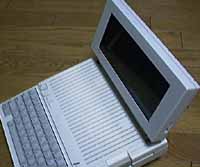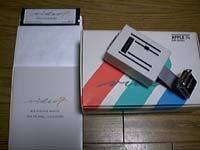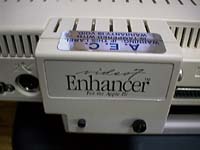 |
VIDEO ACCESSORIES
There are two video outputs at the back panel of IIc.
1つはIIeと同様ビデオモニタ用の標準RCAピンプラグジャック、もうひとつがビデオ拡張用のD-Sub15ピンコネクタである。
One is the standard RCA pin plug jack for video monitor as with IIe and the
other is D-Sub 15 pin connector for video expansion.
アップル社の設計陣はこのビデオ拡張ポートを今後の標準設計とすべく汎用設計としたかったようだが、のちのIIGSに採用したRGBポートとは異なる設計となっており、RGBモニタの進歩と標準設計のはざまにあって、IIcのビデオ拡張ポートは、技術的にみると特殊なものとなっている。
Apple's design team seemed to want to make this video extension port a standard
design for future design, but during the progress of RGB monitor and standard
design, it was designed differently from the RGB port adopted in the later
IIGS,. On the other hand, the video expansion port of IIc is special from the
technical point of view.
これはビデオ入力のないTVシステムに接続するための付属のビデオアクセサリ。
The left photo is a video accessory for
connecting to a TV system without video input.
D-Subコネクタにモジュレータ(上左)を接続し、ここからRCA同軸ケーブルによりTVスイッチボックス(上左)と接続する。
Connect the modulator (upper left) to the D - Sub connector and connect it to
the TV switch box (upper left) with RCA coaxial cable from the box.
スイッチボックスからは300オームの平行フィーダ線でTVへ接続する。
From the switch box connect to the TV with a 300 ohm parallel feeder wire.
チャンネルは3チャンネルと4チャンネルをモジュレータ側にあるスイッチで切り替え可能。
Channels can be switched between 3 and 4 channels with switches on the modulator
side.
小さいパーツであるがきちんとした設計になっている。
There are small accessories, but they are
neat design.
一方、この機能を本体に組み込めなかった点は設計がちょっとちぐはぐな感じもする。
On the other hand, the point that the designer could not incorporate this
function into the main body seems to be slightly wrong.
ビジネスユースとホームユース、ユーザーの対象を絞りきれなかった点とコンパクトな設計の追求により、このような付属品という形に落ち着いたと推察される。The
pursuit of compact design and the point that the target of the user whether
business use or home use could not be narrowed down is presumed to have
concluded the style of such accessories. |




